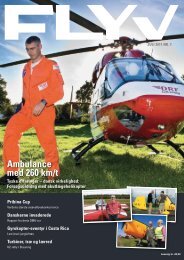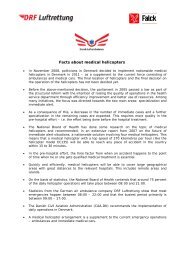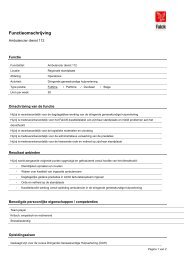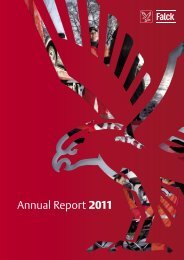Annual Report 2010 - Falck
Annual Report 2010 - Falck
Annual Report 2010 - Falck
You also want an ePaper? Increase the reach of your titles
YUMPU automatically turns print PDFs into web optimized ePapers that Google loves.
Notes to the Group financial statements<br />
Note<br />
1 Accounting policies (continued)<br />
The line items of the financial statements of subsidiaries are<br />
fully consolidated in the consolidated financial statements.<br />
Profit for the year and equity attributable to non-controlling<br />
interests in subsidiaries that are not fully controlled are<br />
included in the consolidated profit and equity and stated as<br />
separate line items.<br />
Associates<br />
Enterprises in which the <strong>Falck</strong> Group exercises significant influence<br />
but not control are classified as associates. Significant<br />
influence is generally achieved by directly or indirectly holding<br />
or controlling more than 20%, but less than 50%, of the voting<br />
rights.<br />
Unrealised gains on transactions with associates are eliminated<br />
in proportion to the Group’s share of the enterprise.<br />
BUSINESS COmBINATIONS<br />
Companies acquired or established during the financial year<br />
are recognised as from the date of acquisition or inception.<br />
Companies divested or discontinued are recognised in the<br />
income statement until the date of divestment. The comparative<br />
figures are not restated to reflect companies acquired,<br />
divested or discontinued.<br />
Acquisitions of subsidiaries or associates are accounted for<br />
applying the acquisition method. Identifiable assets, liabilities<br />
and contingent liabilities of acquirees are stated at their fair<br />
value at the date of acquisition. Identifiable intangible assets<br />
are recognised if they are separable or derive from a contractual<br />
right. Deferred tax on revaluations is recognised.<br />
The acquisition date is the date on which the Group obtains<br />
control of the acquiree.<br />
Any positive difference between the consideration and the value<br />
of non-controlling interests in the acquiree and the fair value<br />
of the previously held interests in the acquiree, on the one<br />
hand, and the fair value of the identifiable assets, liabilities<br />
and contingent liabilities, on the other hand, is recognised in<br />
the balance sheet as goodwill. Goodwill is not amortised, but<br />
is tested for impairment at least once a year. On acquisition,<br />
goodwill is allocated to the cash-generating units which will<br />
subsequently form the basis for future impairment tests. Any<br />
goodwill arising and any fair value adjustments made on the<br />
acquisition of a foreign company whose functional currency is<br />
not the same as the presentation currency used by the Group<br />
are treated as assets and liabilities of the foreign company and<br />
are translated on initial recognition to the foreign company’s<br />
Group | <strong>Falck</strong> <strong>Annual</strong> <strong>Report</strong> <strong>2010</strong> 57<br />
functional currency at the exchange rate ruling at the transaction<br />
date. Any negative difference is recognised in the income<br />
statement on the date of acquisition.<br />
The consideration in a business combination consists of the<br />
fair value of the agreed purchase price. For business combinations<br />
in which the agreement includes a provision on<br />
adjustment of the consideration conditional on future events<br />
(earn-out), the fair value of this part of the consideration is<br />
recognised at the date of acquisition. Any changes in the fair<br />
value of the contingent consideration after initial recognition<br />
are recognised in the income statement. Put options issued in<br />
connection with acquisitions, the value of which is contingent<br />
on future events, are recognised as part of the consideration<br />
at the date of acquisition. The put options issued are subsequently<br />
measured at fair value. Any changes in the fair value of<br />
the issued put options after initial recognition are recognised<br />
in equity. Acquisition costs directly attributable to the acquisition<br />
are recognised in the income statement.<br />
Adjustments of liabilities in connection with contingent consideration<br />
and issued put options, the value of which is conditional<br />
on future events relating to business combinations with<br />
an acquisition date prior to 1 January <strong>2010</strong>, will continue to be<br />
recognised in accordance with IFRS 3 (2004), i.e. adjustments<br />
are recognised in goodwill until the conditions have been met<br />
or the issued put options are exercised.<br />
If uncertainties regarding the measurement of acquired identifiable<br />
assets, liabilities, contingent liabilities or the consideration<br />
for the business combination exist at the acquisition date,<br />
initial recognition takes place on the basis of preliminary fair<br />
values. If identifiable assets, liabilities, contingent liabilities<br />
and the consideration for the business combination are subsequently<br />
determined to have had a different fair value at the<br />
acquisition date than first assumed, goodwill is adjusted until<br />
12 months after the acquisition date. The effect of the adjustments<br />
is recognised in the opening equity, and the comparative<br />
figures are restated accordingly. Goodwill is not adjusted<br />
subsequently except in the event of material errors.<br />
Gains or losses on divestment or winding up of subsidiaries<br />
and associates are stated as the difference between the sales<br />
or disposal amount and the carrying amount of the net assets<br />
including goodwill at the time of sale plus sales or winding<br />
up costs. In addition, any retained non-controlling interests<br />
are measured at fair value. Gains or losses on the divestment<br />
or winding up of subsidiaries and associates and the effect of<br />
renewed measurement of any non-controlling interests are<br />
recognised in the income statement.
















